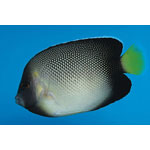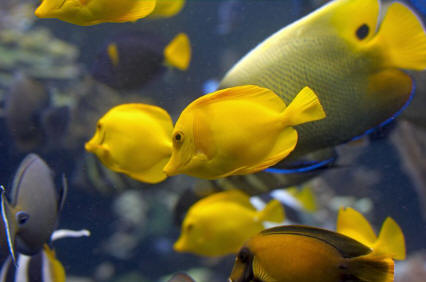Cream Angel

|
Scientific Name: Apolemichthys xanthurus Price: Upon Request Origin: Western Indian Ocean Family: Pomacanthidae NOT AVAILABLE NOW |
|
Other Names: Xanthurus Cream Angelfish, Indian Yellowtail Angelfish, Cream Angelfish, Yellowtail Black Angelfish, Smoke Angelfish |
|
Technical Info
Temperature: 22 - 26 ℃
pH: 8.1 - 8.4
GH: 8 - 12
SG: 1.020 - 1.025
Max size: 20 cm
Min Tank size: 280 Ltr
Position in Aqua: Top swimmer
Description
The Cream Angel has a body that is flat, deep and elongated. Juveniles are a little less elongated. The adult is pale gray or light brown on the main part of the body, with larger black colored scales from the mid body to the dorsal area. From the mid body down to the belly the scales have a pearl white coloring. The head is black to dark brown with a light nose, a bright yellow spot one each side of the temple area, and a bright yellow tail fin. The dorsal and anal fins are black to dark brown with a white to blue trimming on the outer edge. The pelvic fins are white to yellow and the pectoral fins are clearish yellow-white.
Food
The diet should include Spirulina, marine algae, high-quality angelfish preparations, mysis or frozen shrimp, and other meaty items.
Breeding
Has not yet been bred in the aquarium, nor has it been cultivated in any laboratory as of yet. Angelfish generally are broadcast spawners, releasing eggs and sperm simultaneously at dusk. They dance then rise into the water column and release their eggs and sperm near the top of the water. Spawning starts before sunset with females extending all her fins as she swims next to the male. The male will go under the female and nuzzle her belly, then darts down about 6 to 10 cm. The female then turns to her side and both release a white cloud of gametes containing sperm and eggs. Both males and females may mate with several others on the same evening.
Compatible with
The Cream Angel is peaceful and works great in a large peaceful community tank. They only become aggressive toward their own kind and other fish that are added after them if they are kept in a tank that is too small. Clownfish and anthias, though considered semi-aggressive should be okay, just make sure they do not bully your angelfish. Do not house it with dwarf angelfish since dwarves will bully it into not eating, and eventually starvation. Only when it is full grown and established can it be housed with the more aggressive Pomacanthus species and smaller Holacanthus species. They are not considered reef safe. Invertebrates such as larger shrimp, crabs and snails are safe, but they will consume all other types of corals. Even as juveniles they will pick at and eat soft polyp corals, especially Xenia and Anthelia, as well as stony corals and zoanthids.
Note
Cream Angel do not display sexual dimorphism. The sex is unknown, though males may be larger.

